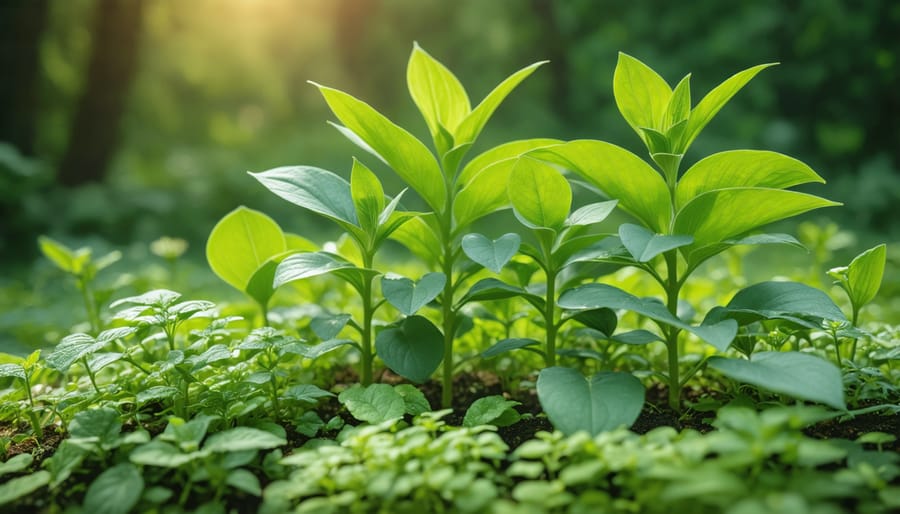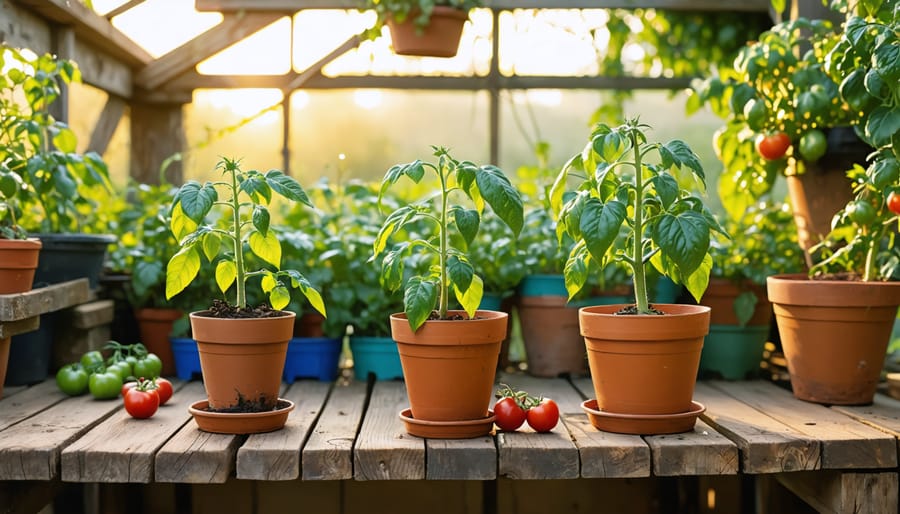Track your seeds backward three generations to guarantee genetic purity and authentic traits in your garden. This simple record-keeping practice—documenting the parent plant, grandparent, and great-grandparent—creates an unbroken chain that proves your tomatoes, beans, or squash haven’t been accidentally cross-pollinated by neighboring varieties. For anyone saving seeds from heirloom varieties, this documentation isn’t just paperwork; it’s your insurance policy against losing centuries-old flavors and characteristics.
Think of a three-generation pedigree as your seed’s family tree. When you know exactly where your ‘Brandywine’ tomato seeds came from for three consecutive growing seasons, you’re confident they’ll produce the same meaty, complex-flavored fruit that made this variety famous. Without this tracking, you might unknowingly plant seeds from a plant that cross-pollinated with a cherry tomato two gardens over, resulting in disappointing harvests and diluted genetics.
The beauty of this system is its accessibility. You don’t need sophisticated software or genetic testing—just a notebook, plant tags, and attention to detail during harvest time. Whether you’re preserving rare varieties for future generations or simply ensuring your favorite pepper maintains its perfect heat level, understanding three-generation pedigrees transforms you from a casual seed saver into a genuine seed steward. This practice connects you to a lineage of gardeners who’ve carefully maintained plant varieties for decades, sometimes centuries, ensuring these treasured genetics survive for those who’ll garden long after us.
What Exactly Is a 3-Generation Pedigree?

The Family Tree of Your Garden
Just like you might trace your own ancestry through grandparents and great-grandparents, plant pedigrees work the same way! A 3-generation pedigree documents your plant’s family history: the seeds you’re saving this year (generation 1), their parent plants (generation 2), and their grandparents (generation 3).
Why does this matter? Think about your family’s traits—maybe your grandmother’s curly hair or your father’s height. Plants inherit characteristics too: disease resistance, flavor, color, and growth habits all pass down through generations. When you know a tomato’s pedigree, you understand whether it’s been reliably producing those sweet, crack-resistant fruits for years, or if it’s a first-generation experiment that might surprise you next season.
Documentation becomes your garden’s memory. Without records, you’re essentially raising orphans—plants with unknown backgrounds that might carry hidden traits or genetic quirks. A simple notebook tracking which seeds came from which plants, year after year, helps you select the best performers and maintain variety purity. It’s not complicated genealogy; it’s just being intentional about preserving the qualities you love most in your garden.
Why Three Generations Matter (Not Two or Four)
You might wonder why seed keepers settled on three generations specifically—why not two, or even five? The answer lies in the sweet spot between practicality and genetic certainty.
Two generations simply isn’t enough time to spot trouble. Imagine you accidentally grew a squash near your cucumbers—the first generation might look fine, but hidden crossing could reveal itself only in the second generation. With three generations, you’re watching long enough to catch these genetic surprises before they become permanent problems.
On the flip side, tracking four or more generations becomes unnecessarily cumbersome for home gardeners. You’d be managing extensive records while the added benefit remains minimal.
Three generations strikes that perfect balance. It gives you enough time to observe genetic stability—those consistent traits appearing year after year—while remaining manageable for backyard seed saving. Think of it as your quality assurance window: the first generation establishes the baseline, the second confirms consistency, and the third validates that you’ve truly captured the plant’s reliable genetic character.
As longtime seed saver Margaret Roach shared with me, “Three generations tells you the story you need to know, without writing an encyclopedia.”
The Real Problem 3-Generation Pedigrees Solve
When Good Seeds Go Bad
I’ll never forget my friend Maria’s “mystery squash” disaster. She’d been saving seeds from her beloved butternut squash for years, but one season she planted them near her neighbor’s zucchini patch. The next year? Strange, bitter-tasting gourds that were somewhere between butternut and zucchini—and not in a good way. Her carefully maintained variety had crossed with the neighbor’s plants, and those saved seeds carried the混ed genetics forward.
This happens more often than you’d think. Master gardener Tom Chen shared a similar tale about his prized heirloom tomatoes. After casually saving seeds for several years without tracking their lineage, he noticed the fruits becoming smaller, less flavorful, and more prone to cracking. Unknown crosses with nearby varieties had slowly degraded what was once his garden’s crown jewel.
Then there’s the case of the color-changing beans. A community garden in Vermont carefully saved their beautiful purple pole beans, only to find pale lavender and even green pods appearing by the third generation. Without isolation or careful selection, off-types had crept in unnoticed.
These aren’t failures—they’re learning experiences. Each story illustrates why tracking seed lineage matters. Without knowing a seed’s history and parentage, you’re essentially gardening blind, hoping that what you plant will resemble what you loved last season.
Protecting Heirloom Varieties for Future Gardeners
When you maintain a 3-generation pedigree for heirloom varieties, you’re doing more than just growing great tomatoes or beautiful flowers—you’re becoming a guardian of our shared agricultural heritage. Many rare heirloom varieties exist only because dedicated gardeners like you have kept their seeds pure and viable through careful selection.
This work connects directly to the seed sovereignty movement, which empowers communities to control their own seed supplies rather than depending on large corporations. Each time you isolate a variety and track its lineage, you’re preserving genetic diversity that might otherwise disappear forever.
I recently spoke with Maria Chen, a seed library coordinator, who shared this perspective: “Every gardener who maintains clean heirloom lines is creating a genetic backup for our food system. These aren’t just seeds—they’re living libraries of adaptation and resilience.”
Your careful record-keeping ensures that the ‘Cherokee Purple’ tomato or ‘Moon and Stars’ watermelon your great-grandchildren grow will be the same treasured variety you’re cultivating today. That’s a legacy worth protecting, one growing season at a time.
How to Track a 3-Generation Pedigree in Your Garden
Starting Your First Generation (Even If You’re Behind)
Good news—you don’t need to start with perfect records from three years ago! You can begin tracking your pedigree right now, even mid-season, and build your documentation forward.
Start by tagging your current plants with simple, durable labels. Include the variety name, source, and today’s date. If you saved seeds from these plants in previous years, note that too—it’s valuable information even without complete records. Use weatherproof tags or permanent markers on plastic labels; I’ve learned the hard way that pencil on wooden stakes fades faster than you’d think!
Create a basic tracking system that works for you. A simple notebook, spreadsheet, or garden journal will do. Record which plants you’re selecting for seed saving and why—maybe they’re the earliest producers, most disease-resistant, or have exceptional flavor. Take photos throughout the season; they’re incredibly helpful for remembering which plants performed best.
When harvest time arrives, keep seeds from your tagged plants separate and label each packet with the variety, date, and “Generation 1” or “G1.” This becomes your starting point.
Remember, renowned seed saver Rowen White once told me, “Every generation you track is a gift to the future, even if you’re starting today.” Your first generation begins now—that’s what matters most.
Isolation Techniques That Actually Work at Home
Let’s be honest—most of us aren’t working with acres of farmland! But maintaining genetic purity for your three-generation pedigree doesn’t require endless space. It requires creativity and planning.
**Distance isolation** remains your best friend. Even 20-30 feet can significantly reduce cross-pollination for many vegetables. Position squash varieties at opposite ends of your garden, or plant early-season crops on one side and late-season on the other. Your backyard is larger than you think when you use it strategically!
**Time isolation** works beautifully in smaller spaces. Stagger plantings so different varieties bloom weeks apart. I plant my early cherry tomatoes in March and my heirlooms in May—they rarely overlap, keeping lines pure without extra space.
**Physical barriers** create surprisingly effective boundaries. Row covers, mesh cages, or even strategically placed tall crops like corn or sunflowers can interrupt pollen flow. One gardener I interviewed uses inexpensive tulle netting to hand-pollinate and protect her prize pepper varieties.
For detailed guidance on spacing requirements for different crops, check out these proven isolation strategies.
Remember, perfect isolation isn’t always necessary. Focus your strictest efforts on varieties you’re committed to tracking through multiple generations. Give yourself grace—seed stewardship is a journey, not a competition!


Simple Record-Keeping Methods (No Fancy Systems Required)
You don’t need expensive software or complicated spreadsheets to track your three-generation pedigrees—sometimes the simplest methods work best!
**The Notebook Approach**: A dedicated garden journal remains a favorite among seasoned seed savers. Date each entry, note the parent plants’ characteristics, and sketch a simple family tree. One gardener I spoke with keeps a binder with plastic sleeves for seed packets alongside her handwritten notes—brilliantly simple and weatherproof.
**Photo Documentation**: Your smartphone is a powerful tracking tool. Photograph each generation with a dated label visible in the shot. Create folders by plant variety and year. This visual record helps you remember which ‘Cherokee Purple’ tomato was the sweetest or which bean plant showed exceptional vigor.
**Physical Plant Tags**: Use weatherproof markers to label plants directly in the garden. Color-coded tags work wonders—blue for Generation 1, green for Generation 2, and so on.
**Digital Options**: If technology suits your style, basic spreadsheets or free apps like Google Sheets let you track lineage without overwhelming complexity. But remember: consistency matters more than sophistication. Choose whatever method you’ll actually maintain season after season.
Which Plants Actually Need This Level of Care?
The High-Priority List
When you’re just starting with three-generation pedigrees, focus your energy where it matters most. Some crops practically demand careful tracking because they’re either promiscuous cross-pollinators or possess traits too precious to lose.
Tomatoes top the list for good reason. While they’re mostly self-pollinating, bees occasionally play matchmaker between varieties. Track their lineage to preserve that perfect balance of sweetness and acidity you’ve been cultivating. Peppers follow similar rules—bumblebees love hopping between hot and sweet varieties, creating surprise crosses that can turn your mild bell peppers unexpectedly spicy!
Beans and peas are wonderful beginner choices since they’re reliable self-pollinators. Their three-generation records help you lock in desirable traits like pod length, disease resistance, or that buttery flavor you’ve come to love.
Lettuce deserves attention too. It self-pollinates before opening its flowers, making it relatively stable, but those prized qualities—crisp texture, slow bolting, vibrant color—need monitoring across generations to ensure they’re breeding true.
These crops reward your record-keeping efforts with predictable results and genetic stability. Master tracking these high-priority vegetables first, and you’ll build confidence before tackling trickier crops like squash or corn that require more complex isolation techniques.
When You Can Relax a Little
Here’s the good news: not every plant requires the same level of vigilance when tracking three generations. Self-pollinating crops like tomatoes, beans, peas, and lettuce are naturally forgiving friends in your seed-saving journey. Because they primarily pollinate themselves before their flowers even open, these plants maintain genetic consistency without demanding your constant attention to isolation distances.
With self-pollinators, occasional cross-pollination might happen, but it’s rare enough that most seed savers feel comfortable being more relaxed about their pedigree records. You might notice a slightly different leaf shape or growth habit pop up occasionally—and that’s perfectly fine! In fact, some experienced gardeners welcome these small variations as opportunities to discover unique traits worth preserving.
Similarly, if you’re growing heirloom varieties where some diversity adds character rather than diminishing value, you can ease up on strict tracking. Heritage varieties of lettuce with color variations or beans with slightly different patterns can still be considered true-to-type even with minor differences.
The key is understanding your goals. Are you stewarding a rare variety that must remain genetically pure, or are you simply maintaining a reliable family favorite? For many home gardeners, perfect uniformity matters less than flavor, productivity, and adaptability to your specific garden conditions.
Real Seed Stewards Share Their Experience
I reached out to three experienced seed savers to learn how they approach pedigree tracking in their own gardens. Their candid stories reveal both the challenges and rewards of this practice.
**Martha Chen, 15 years of seed saving:**
“My biggest mistake was thinking I could remember everything without writing it down,” Martha laughs. “I had beautiful tomatoes in year two, but by year three, I’d mixed up which plant was which parent. Now I use weatherproof tags and photograph each generation with a whiteboard showing the lineage. It sounds fussy, but it takes maybe five extra minutes per plant.”
What surprised her most? “The genetics become visible so quickly! By generation three, I could see my sweet peppers getting thicker walls and better disease resistance. That’s when the ‘three generation’ concept really clicked for me.”
**David Okonkwo, seed library coordinator:**
“We teach beginners to start with just one variety for their first pedigree project,” David explains. “People get overwhelmed trying to track five different crops at once. Pick your favorite tomato or bean, follow it for three years, and you’ll learn the system naturally.”
His top tip? “Keep it simple. A basic notebook beats a fancy spreadsheet you’ll never update. Write the parent plant number, date, and one observation about why you selected it. That’s honestly enough.”
**Rosa Dominguez, heirloom specialist:**
“The three-generation framework taught me patience,” Rosa shares. “Modern gardening wants instant results, but watching traits stabilize over three years connects you to how our ancestors developed every heirloom we treasure. You’re not just growing food—you’re participating in plant evolution.”
You don’t need to be perfect to start making a meaningful difference in seed preservation. If you’ve been waiting for the “right time” or worrying about making mistakes, I encourage you to simply begin. Choose just one variety this season—maybe that beloved tomato that’s been in your garden for years—and start recording its story.
The beauty of three-generation pedigree tracking is that it grows with you. Your first season might involve nothing more than a notebook and some dated photos. That’s absolutely enough. Each growing season builds on the last, and before you know it, you’ll have created something invaluable: a documented lineage of a plant variety, preserved through your careful attention.
There’s something deeply rewarding about becoming a seed steward. You’re not just growing vegetables; you’re participating in an ancient tradition of saving, selecting, and passing forward. Your observations matter. Your seeds matter.
So grab that notebook, pick your variety, and let this growing season be the one where you start. The plants don’t need perfection—they just need someone who cares enough to pay attention and keep their story alive.

